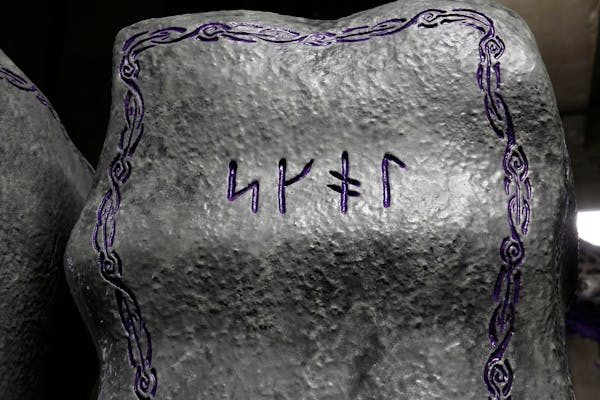The Minnesota Vikings want to know how loud is loud at U.S. Bank Stadium.
"In our short stay so far, it's been pretty good," veteran linebacker Chad Greenway said.
The team has played three games in the huge new $1.1 billion arena, nearly twice the size of the Metrodome it replaced. The Vikings (5-2) won all three home games in resounding fashion, but after dropping the last two road games, coach Mike Zimmer said at his post-practice news conference Friday, "We need our fans to be loud."
Anecdotal assessments by fans, journalists, coaches and players indicate it gets hard to hear everywhere in the stadium — from concourses to the field, seats and the press box. Random, unscientific sound tests around the stadium back that notion.
But for the next two home games — noon Sunday vs. the Detroit Lions, and Nov. 20 vs. the Arizona Cardinals — Minneapolis-based Parsons Electric will set up equipment in two locations to test sound levels. The Vikings will review the results before deciding what sort of tests to run when the Dallas Cowboys come to town on Dec. 1, said Bryan Harper, team vice president for content and production.
"We can already be proud of the building and how loud it is," Harper said. Nevertheless, he added, "We want an answer beyond, 'Yeah, it's really loud in there.' "
Noise connoisseurs
The critical variable is team performance. The better the play, the louder the fans.
Vikings fans, Zimmer said, are "extremely educated and extremely loud, especially when we do good things."
Defensive end Everson Griffen said fans can be a little too enthusiastic when the offense is playing. His message: The noise helps when the Vikings defense is on the field but not when the Vikings offense has the ball and the quarterback may want to change plays at the line of scrimmage.
Acoustically, Griffen said, the echo on the field is so loud he can't make out the pregame tunes during warmups.
Greenway, however, said he thinks the Metrodome, at half the size, was louder. "Wicked loud" was how he put it.
The loudest place he's played? The Superdome in New Orleans during the 2009 NFC Championship Game, he said. The Vikings lost that game, but the noise reflected the quality of the play and the significance of the game — one that sent the winner to the Super Bowl and was quarterback Brett Favre's last playoff game.
After the noise tests during the next two Sundays, the Vikings will have graphs showing the ebbs and flows of the sound at points throughout the games. Testing equipment will be placed at four different points near the field.
"Hopefully, we'll have a story to tell," Harper said.
A proud local tradition
Noise certainly factored into the story of the Metrodome, where the Vikings played from 1982 through 2013 and the Minnesota Twins won two earsplitting World Series. Both teams were accused of amplifying the crowd sound by piping in synthetic noise — a charge they vigorously denied — to create what became known as "the Dome-field advantage."
In the Dome years, the Vikings had the NFL's second-highest differential between home (.644) and road (.404) winning percentages, according to ESPN Stats and Information. Since 2006, according to Pro Football Reference, NFL defenses playing home games indoors averaged 2.4 sacks per game vs. 2.33 outdoors.
Like the Dome, U.S. Bank Stadium also has a roof. But in addition to dwarfing the Dome, it has five massive glass doors that will likely be open Sunday, which should let out some of the racket.
During Game 7 of the 1987 World Series at the Metrodome, volume levels reached 125 decibels, the equivalent of a Boeing 727 aircraft taking off 900 feet away, according to a study by the University of Minnesota.
Sound levels are measured in decibels. The measurement is logarithmic, so a sound that is twice as loud as a reference sound is an increase of about three decibels. Zero decibels is the lowest level of perceptible hearing. On the scale, a 10-decibel sound would be 10 times the intensity of the reference sound. A 20-decibel sound is 100 times the reference intensity.
Normal conversation occurs at about 60 decibels; loud rock music 120 decibels.
Hoping to be loudest
Harper said initial tests from random spots throughout U.S. Bank Stadium reported decibels ranging from 112 to 124, although he added that he's skeptical of the higher number.
Zimmer said he'd like U.S. Bank Stadium to be the loudest venue in the NFL. That distinction now belongs to Arrowhead Stadium in Kansas City, an open-air facility that recorded a decibel level of 142.2 in September 2014, breaking the record of 137.6 set by Seattle Seahawks fans the previous year.
Fans at Sunday's game need not worry about getting too loud for the Vikings defense. Greenway said that when they can't hear one another, players get focused deeply in their heads "because that's all you've got to talk to."
Rochelle Olson • 612-673-1747
Twitter: @rochelleolson
Hopkins parents charged in 9-year-old daughter's deadly asthma attack

Back to blue: Lake Harriet Band Shell renovation almost finished

What St. Paul gardeners need to know about the city's new boulevard garden rules

